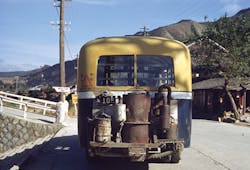OGJ writers believe contrast makes for a good story. This editor cannot look at the World War II-era bus, shown, without thinking how much more convenient it would have been if the post-war Japanese had natural gas vehicles (NGVs) and access to today's abundant natural gas supplies.
Instead, many civilian vehicles in Europe and Japan were converted to run on gases produced from burning coal or wood after the war. Digital files from the Texas Medical Center Library archives suggest this Japanese bus ran on gases produced from burning charcoal.
That was in 1949 when gasoline was scarce after a devastating war. Today, US unconventional plays yield enough natural gas to the point where various gas export terminals are being constructed to send US gas to Asia and elsewhere.
NGV owners can tap into those abundant supplies, either here or abroad. Numerous manufacturers offer fleet vehicles such as trucks and buses that run on compressed natural gas. But options remain more limited for consumers looking for a light-duty CNG car or pickup truck.
Some choices are CNG versions of the Honda Civic, Chevrolet Silverado, Dodge Ram, and Ford F-250 pickups as well as the Ford Transit and Transit Connect vans. Outside of purchasing a CNG vehicle, some individuals have converted vehicles to run on natural gas or else bought a CNG vehicle through a government auction of preowned fleet vehicles.
Meanwhile, public transportation fleets, including some Houston city buses, have used CNG for decades. It's estimated 12-15% of US public transit buses run on CNG or LNG, and their popularity was growing before low fuel prices of late might have stalled some interest, at least for now.
States having the highest consumption of natural gas for transportation are California, New York, Texas, Georgia, Massachusetts, and Washington, DC. Interestingly, Utah had the most CNG stations per capita and more than 5,000 CNG vehicles on the roads.
The US Department of Energy reports natural gas powers about 150,000 US vehicles and roughly 15.2 million vehicles worldwide.
CNG pickup
This editor's only direct experience with a CNG vehicle so far has been a pickup truck belonging to Mitchell Energy during the late 1980s or early 1990s.
George Mitchell was very keen on promoting NGVs, and he encouraged journalists to drive his vehicle while on a field trip in the Barnett shale to learn about fracturing.
If memory serves, the Mitchell CNG pickup was bi-fuel, meaning it could run on either natural gas or gasoline.
Mitchell helped develop technology in the Barnett shale that launched today's wide use of horizontal drilling and hydraulic fracturing.
He loved telling reporters how he kept instructing engineers to figure out how to tap into the source rock even as those engineers suggested that he was wasting money. Much of the credit behind today's successful unconventional plays probably stems from Mitchell's refusal to take 'no' for an answer.
Many other companies adopted Mitchell's techniques, and US gas production escalated. Mitchell sold Mitchell Energy to Devon Energy Corp. in 2002 for about $3 billion.
Needless to say, Mitchell's CNG pickup truck did not look like the converted Japanese bus pictured although Mitchell did serve as a captain in the US Army Corps of Engineers during WWII.
He got into the oil and gas business in 1946 by joining a new exploration company, Oil Drilling, which eventually became Mitchell Energy. Later in life, Mitchell invested in the Marcellus shale in Pennsylvania before he died in 2013.
*Paula Dittrick is editor of OGJ's Unconventional Oil & Gas Report.
About the Author
Paula Dittrick
Senior Staff Writer
Paula Dittrick has covered oil and gas from Houston for more than 20 years. Starting in May 2007, she developed a health, safety, and environment beat for Oil & Gas Journal. Dittrick is familiar with the industry’s financial aspects. She also monitors issues associated with carbon sequestration and renewable energy.
Dittrick joined OGJ in February 2001. Previously, she worked for Dow Jones and United Press International. She began writing about oil and gas as UPI’s West Texas bureau chief during the 1980s. She earned a Bachelor’s of Science degree in journalism from the University of Nebraska in 1974.


